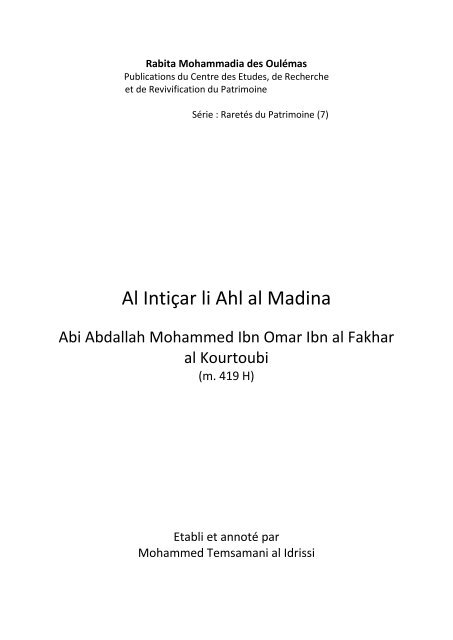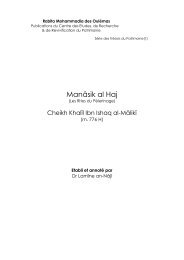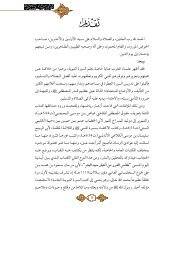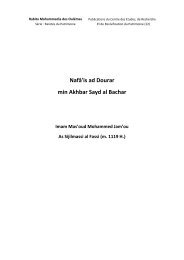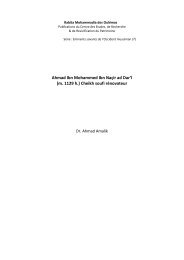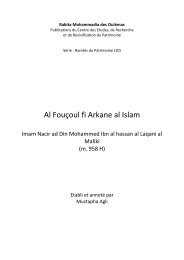Create successful ePaper yourself
Turn your PDF publications into a flip-book with our unique Google optimized e-Paper software.
Rabita Mohammadia des Oulémas<br />
Pub<strong>li</strong>cations du Centre des Etudes, de Recherche<br />
et de Revivification du Patrimoine<br />
Série : Raretés du Patrimoine (7)<br />
<strong>Al</strong> <strong>Intiçar</strong> <strong>li</strong> <strong>Ahl</strong> <strong>al</strong> <strong>Madina</strong><br />
Abi Abd<strong>al</strong>lah Mohammed Ibn Omar Ibn <strong>al</strong> Fakhar<br />
<strong>al</strong> Kourtoubi<br />
(m. 419 H)<br />
Etab<strong>li</strong> et annoté par<br />
Mohammed Temsamani <strong>al</strong> Idrissi
<strong>Al</strong> Intisar <strong>li</strong> <strong>Ahl</strong> <strong>al</strong> <strong>Madina</strong><br />
(Primacy of the <strong>Madina</strong> Ulemas)<br />
Abi Abd<strong>al</strong>lah Mohammed Ibn Omar Ibn <strong>al</strong> Fakhar <strong>al</strong> Kurtubi<br />
(d. 419 H)<br />
This book de<strong>al</strong>s, among others, with the contradiction and the mistakes of the Chafi’I<br />
School and of issues of Abu Hanifa.<br />
The Ma<strong>li</strong>kite Fouqaha are known for their devotion to the Ma<strong>li</strong>kite School and<br />
their writings about it. Unfortunately a very sm<strong>al</strong>l number of these writings reached<br />
us in a printed form, among which the book of Ibn Labad, Tahdib <strong>al</strong> Masa<strong>li</strong>k fi Nusrat<br />
Madhab Ma<strong>li</strong>k of <strong>al</strong> Fand<strong>al</strong>awi or Intisar <strong>al</strong> Faqir as Sa<strong>li</strong>k <strong>li</strong> Tarjih Imam Ma<strong>li</strong>k of ar Ra’i.<br />
Others remain in a manuscript form and still await to be pub<strong>li</strong>shed such as this book,<br />
as ad Dhab ‘an Madhab Ma<strong>li</strong>k of Abi Zayd <strong>al</strong> Qayrawani, and as Tanbih ‘<strong>al</strong>a Shudhud<br />
Ibn Hazm of Abi <strong>al</strong> Asbagh Ibn Sahl. These writings belong to an editing mode<br />
common to leading figures of the various schools from ages and highly participated to<br />
the perennia<strong>li</strong>ty of the re<strong>li</strong>gion pillars and to their safeguard [against contradictory<br />
views]. If some of these books have sectarian features, numerous others have a high<br />
scientific v<strong>al</strong>ue because they provide a go back to the root studies of [ijtihad]<br />
contentious issues and because they open a deep debate on the credit of some<br />
sources and rules.<br />
In this book the author answers to Ibn Hazm ath Thahiri –without naming<br />
him– at the beginning of the latter’s celebrity in And<strong>al</strong>usia, at the time where his ideas<br />
began to be known; these ideas being extern<strong>al</strong> to the Ma<strong>li</strong>kite school sources and<br />
contradictory with his country’s Fouqaha consensus, the matter that compelled the<br />
most important among them –in that time’s And<strong>al</strong>usia– to disapprove him, to write<br />
texts answering him and to high<strong>li</strong>ght the inva<strong>li</strong>dity of his school. This campaign of the<br />
Fouqaha against Ibn Hazm undoubtedly contributed to strengthen the Ma<strong>li</strong>kite School<br />
in And<strong>al</strong>usia and to ensure its dominance.<br />
The author is one of the most important Fouqaha of the Cordoba Ma<strong>li</strong>kite<br />
School, known for his memorization capacity. He knew by heart some Ma<strong>li</strong>kite<br />
jurisprudence texts such as the Muduwana, the Nawadir az Ziyadate as well as the<br />
Hadith. He was known for his great culture, his good knowledge of the various trends<br />
and his capacity to choose the good way. The Ulemas were unanimous in recognizing<br />
his mastering of Fiqh and his erudition in Islamic science. For the Imam Aba ‘Amru ad<br />
Dani he was the most important Faqih with a sound knowledge of Quran and Sunna in<br />
And<strong>al</strong>usia. In this book, concerning issues relating to re<strong>li</strong>gious practice and to acts<br />
concerning sel<strong>li</strong>ng we see him attached to authenticity and precision, to the just<br />
interpreting of quoting and to the wise and c<strong>al</strong>m debate.
This edition has been enriched by the remarkable work of Dr Mohammed<br />
Temsamani who excelled in his annotations and commentaries, references of texts<br />
and Hadiths, his abundant study about the various Fiqh trends and the preference<br />
given to M<strong>al</strong>ekite School, the authentication of the book and the identification of the<br />
authors of quotations…<br />
Moreover the pub<strong>li</strong>cation of this book provides us with a vivid example of the<br />
debate on Fiqh by the re<strong>li</strong>gious sphere in the Hegira 5th century And<strong>al</strong>usia and<br />
provides us with an important legacy of a great And<strong>al</strong>usian Ma<strong>li</strong>kite <strong>Al</strong>em and Faqih<br />
that researchers hoped for a long time to consult.<br />
Translation : Mekaoui Abdé<strong>li</strong>lah
<strong>Al</strong> <strong>Intiçar</strong> <strong>li</strong> <strong>Ahl</strong> <strong>al</strong> <strong>Madina</strong><br />
(Primauté des Oulamas de Médine)<br />
Abi Abd<strong>al</strong>lah Mohammed Ibn Omar Ibn <strong>al</strong> Fakhar <strong>al</strong> Kourtoubi<br />
(m. 419 H)<br />
Ce <strong>li</strong>vre traite, entre autres, de la contradiction et des erreurs de l’école<br />
Chafi’i, ainsi que de questions de Abou Hanifa.<br />
Les Fouqaha de l’école M<strong>al</strong>ékite sont connus pour leur dévouement à cette<br />
dernière et pour la rédaction à son propos de divers ouvrages dont un tout petit<br />
nombre nous est parvenu sous forme imprimée, tels que le <strong>li</strong>vre de Ibn <strong>al</strong> Labad,<br />
Tahdib <strong>al</strong> Masa<strong>li</strong>k fi Nousrat Madhab Ma<strong>li</strong>k de <strong>al</strong> Fand<strong>al</strong>aoui ou <strong>Intiçar</strong> <strong>al</strong> Faqir as Sa<strong>li</strong>k<br />
<strong>li</strong> Tarjih Imam Ma<strong>li</strong>k de ar Ra’i. D’autres subsistent toujours sous forme de manuscrits<br />
et sont en attente d’être édités ; c’est le cas du présent ouvrage, de ad Dhab ‘an<br />
Madhab Ma<strong>li</strong>k de Abi Zayd <strong>al</strong> Qayraouani, et de Tanbih ‘<strong>al</strong>a Shoudhoud Ibn Hazm de<br />
Abi <strong>al</strong> Açbagh Ibn Sahl. Ces <strong>li</strong>vres appartiennent à un mode de rédaction commun aux<br />
sommités des diverses écoles depuis les premiers temps et a grandement participé à<br />
assurer d’une part la pérennité des pi<strong>li</strong>ers et d’autre part leur sauvegarde [contre les<br />
avis contradictoires]. Si certains de ces <strong>li</strong>vres ont les traits du sectarisme, nombreux<br />
d’autres ont une grande v<strong>al</strong>eur scientifique car ils présentent des études de retour<br />
aux sources des questions [d’ijtihad] <strong>li</strong>tigieuses de même qu’ils ouvrent un débat<br />
profond sur le crédit de certaines sources et règles.<br />
L’auteur répond aussi, dans ce <strong>li</strong>vre, à Ibn Hazm ath Thahiri –sans citer son<br />
nom– au début de la célébrité de ce dernier en And<strong>al</strong>ousie et au moment où ses idées<br />
commencèrent à être connues ; ces idées étant externes aux sources de l’école<br />
M<strong>al</strong>ékite et en contradiction avec le consensus des Fouqaha de son pays, ce qui<br />
poussa les plus importants parmi eux –dans l’And<strong>al</strong>ousie de cette époque– à le<br />
désavouer, à rédiger des textes pour lui répondre et à mettre en évidence la nul<strong>li</strong>té de<br />
son école. Cette campagne des Fouqaha contre Ibn Hazm a sans doute contribué à<br />
affermir l’école M<strong>al</strong>ékite en And<strong>al</strong>ousie et à y assurer sa prééminence.<br />
Il est à remarquer que l’auteur est l’un des Fouqaha les plus importants de<br />
l’école m<strong>al</strong>ékite de Cordoue, connu pour sa capacité de mémorisation. Il connaissait<br />
par cœur certains textes de jurisprudence m<strong>al</strong>ékite tels que le Moudouwana, le<br />
Nawadir az Ziyadate, ainsi que le Hadith. Il était connu pour sa vaste culture, sa bonne<br />
connaissance des différents courants et sa capacité à choisir la bonne voie. Les<br />
Oulémas étaient unanimes pour reconnaître sa maîtrise du Fiqh et son érudition en<br />
science Islamique. L’Imam Aba ‘Amrou ad Dani le reconnaissait comme le plus<br />
important Faqih à la connaissance affermie du Coran et de la Sounna en And<strong>al</strong>ousie.<br />
Dans le présent ouvrage, et concernant les questions relatives à la pratique re<strong>li</strong>gieuse
et aux actes de vente, nous le voyons attaché à l’authenticité et la précision, à l’exacte<br />
et juste interprétation des citations, ainsi qu’au débat sage et pondéré.<br />
La présente édition a été enrichie par le travail remarquable réa<strong>li</strong>sé par le Dr.<br />
Mohammed Temsamani qui a excellé dans ses annotations et commentaires, ses<br />
référencements des textes et hadiths, son étude abondante sur les différents<br />
courants du Fiqh et la préférence accordée au rite m<strong>al</strong>ékite, son authentification de<br />
l’ouvrage et sur l’identification des auteurs des citations…<br />
Par ailleurs, la pub<strong>li</strong>cation de cet ouvrage nous présente un exemple vivant du<br />
débat sur la jurisprudence mené par le mi<strong>li</strong>eu de la science re<strong>li</strong>gieuse en And<strong>al</strong>ousie<br />
au 5e siècle de l’Hégire et nous fait connaître un legs important d’un grand ‘<strong>Al</strong>em et<br />
Faqih m<strong>al</strong>ékite and<strong>al</strong>ou que les chercheurs espéraient consulter depuis longtemps.<br />
Traduction : Mekaoui Abdé<strong>li</strong>lah


